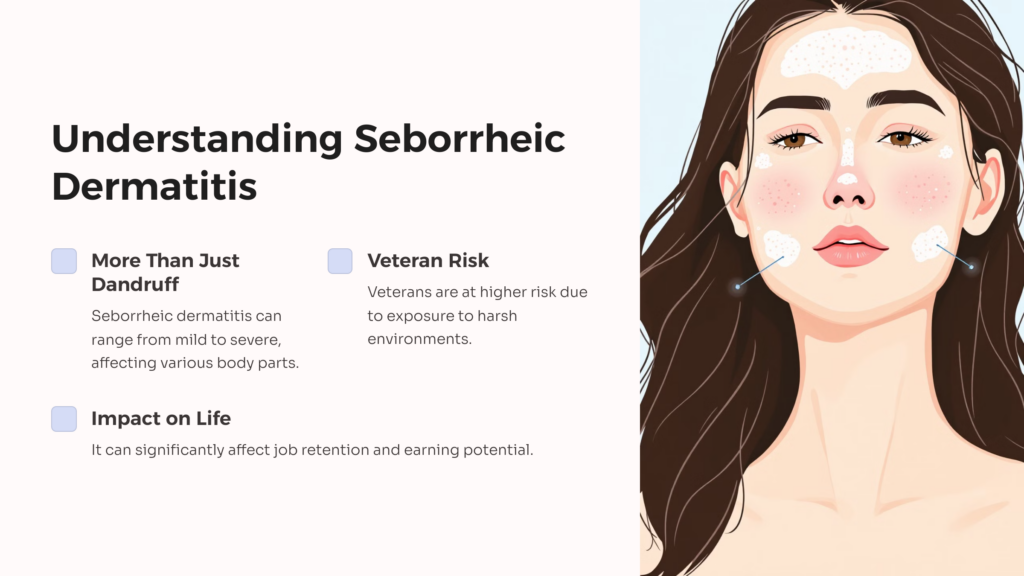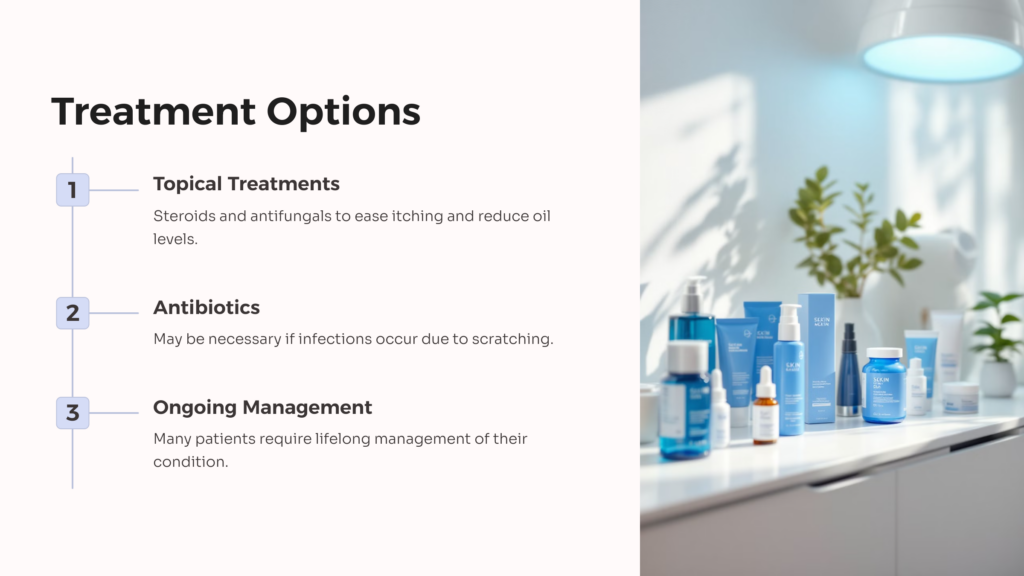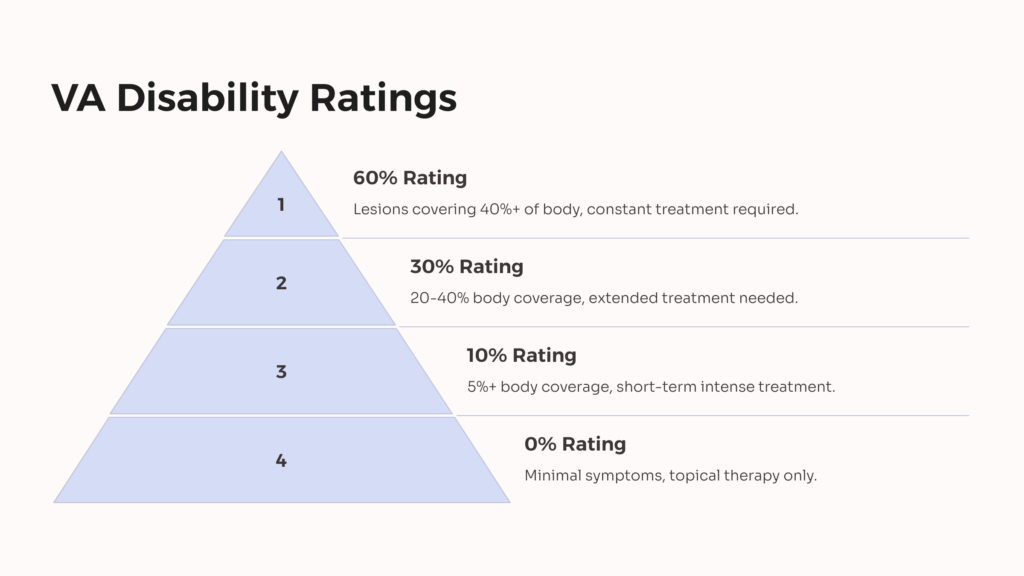Some conditions are obviously an interruption to a vet’s daily life, even just on paper. Others may seem less urgent or debilitating, even if they still prove disruptive to their livelihood.
Some, on the other hand, may sound less problematic at first, but only until you see the individual with the condition in person.
Seborrheic dermatitis is a skin condition that can range from rather mild to extremely severe. Veterans are at higher risk for this skin condition, and it can significantly impact their ability to keep jobs and earn a living. This article will help you understand why, how to identify if you might have it, and if you might qualify for a VA disability benefit.

Seborrheic Dermatitis—Hard to Pronounce, Easy to Understand
Put simply, seborrheic dermatitis is dandruff. A skin condition that causes irritation, dryness, and flaky scales, it’s most commonly seen on the scalp and tends to be mild for the majority of patients.
That’s civilians, though. Veterans often find themselves in places and doing things that leave them exposed to risk factors well beyond what the rank and file of the population experience. As a result, they often end up with conditions similar to what others get, but with much greater severity.
Where the average case of “dandruff” only sees flaky skin on the scalp, and perhaps near other hairy areas on the head (facial hair, eyebrows, etc.), the condition can be seen elsewhere in more aggressive cases.
For these patients, they may find dry, scaly skin in white or yellow greasy patches just about anywhere on the body. It may look like normal dandruff, or take slightly darker or yellower coloring. It may even look more like a ring-shaped rash.
Critically, it may very likely itch, and intensely so. Which can lead to a secondary problem: sores and lesions. Worst of all, it may also resist every attempt to address the problem with at-home or over-the-counter solutions.
Veterans dealing with seborrheic dermatitis can submit a VA disability claim and receive VA disability benefits and disability compensation for the condition. VA benefits are awarded to veterans dealing with service-connected conditions, and the VA disability compensation helps make up for the medical bills and the lost ability to work.

“It’s Just Dandruff; How Bad Can It Really Be?”
If you’re reading this, we imagine you’re hearing this question a lot more than you’re asking it. Instead, you’re probably intimately familiar with how frustrating and disruptive skin conditions can be:
- Severe itching over the entire body, not just scalp. The itching can be so bad you’re constantly distracted by it and probably losing sleep over it.
- Self-consciousness and embarrassment, possibly such that it impacts your mental health to a non-trivial degree.
- Scratching at patches so hard you break the skin, leading to infections and similar problems.
- Patches that become painful, produce fluid/pus or build up scabs.
All of this can mean you’re struggling to find jobs, struggling to keep jobs, and struggling to work jobs even when you have them. And that, friends, is how the same condition that embarrasses teenagers can directly impact your livelihood.
How Is Seborrheic Dermatitis Treated?

Seborrheic dermatitis treatment, like most treatment for chronic skin conditions, will depend in part on the severity of symptoms and the triggers/causes of symptoms.
Normal dandruff is the byproduct of interplay between your body’s natural oils and some naturally occurring fungi that hang out on your skin (usually harmlessly). But for anyone who’s been exposed to intense irritants or substances that can do lasting harm to the skin, things can get a bit more complicated, and you may be dealing with more than one form of dermatitis.
The standard treatment methods, though, involve steroids, antifungals, and a few other topical therapy medications aimed at easing the itching, reducing the oil levels, and minimizing the flaking. If anything has become infected, you may need some additional topical treatments and possibly antibiotics.
Unfortunately, while some cases clear up over time, many patients find themselves managing their dermatitis for extended periods, or even their whole lives.
How Did My Service Lead to This Condition?
Serving in the military can involve any number of harsh environments and hazardous circumstances. If you’re already prone to allergies or skin reactions, you’re already at a disadvantage for chronic skin conditions. But even veterans with an otherwise resilient epidermis can find themselves scratching desperately like they have chicken pox after exposure to the wrong stuff.
Noteworthy examples include things in the “presumptive service connection” category, like Agent Orange and burn pits. The caustic nature of the materials in question are, unsurprisingly, not too great for your skin, and may have had a lingering influence on its health if you’ve been exposed.
Does the VA Even Rate Something as Standard as “Dandruff?”
Yes, in fact, the VA rating might surprise you, though they tend to lump all skin conditions (dermatitis being the technical term) together under a single umbrella.
Rating disabilities often goes case by case, so there is no set seborrheic dermatitis VA disability rating that the VA gives to every veteran with the skin condition. The VA rating can range depending on the severity of the skin condition. The higher the VA disability rating, the more VA disability compensation and VA benefits can be offered.

- 0%: You’ve only needed topical therapy in the past year, and there’s next to nothing in the way of lesions, scars, or disfigurement (specifically of the face, neck, and head).
- 10%: If 5% or more of the body is covered in lesions/scars/disfigurement, and/or you’ve needed more intense treatments like steroids, photochemotherapy, PUVA, or immunosuppressants for up to six weeks in the past 12 months.
- 30%: Lesions covering 20 to 40 percent of the body; “systemic therapy” (like mentioned above) required for more than 6 weeks in the past year.
- 60%: Lesions covering 40% or more of the body, and advanced treatments as before, but required constantly (or near constantly).
Notably, the ratings include language pointing specifically to the potential impact that skin disfigurement might have on a vet’s ability to maintain employment. It’s a sad necessity, but it’s at least nominally reassuring that such a challenge is explicitly acknowledged.
More Than Just a Surface-Level Problem
Sometimes, just asking for help can be embarrassing and intimidating. But that only gets worse when the issue in question seems both “non-critical” and embarrassing in and of itself.
Don’t let that stop you from seeking the help you need, and that you likely deserve. VA disability benefits can help you deal with your skin condition. Just because it sounds more superficial doesn’t mean that it’s not having a material impact on your life, or that you’re less entitled to a disability claim. Your struggles are just as valid as those of any other veteran.
 AllVeteran.com Advisors
AllVeteran.com Advisors
With expertise spanning local, state, and federal benefit programs, our team is dedicated to guiding individuals towards the perfect program tailored to their unique circumstances.











